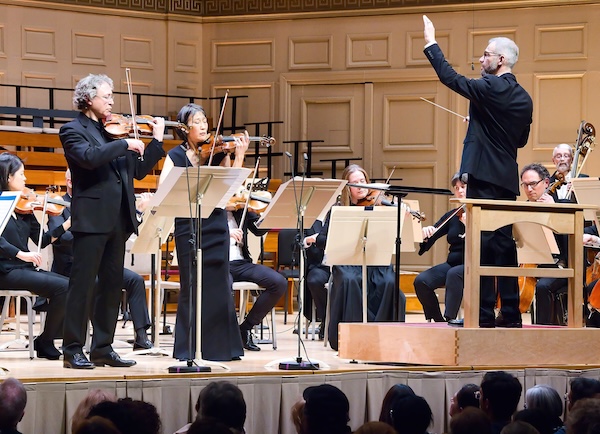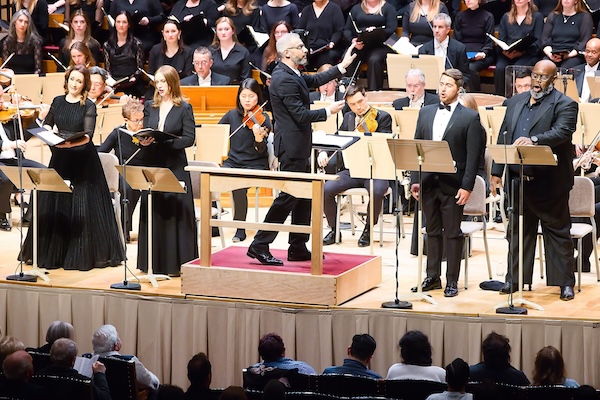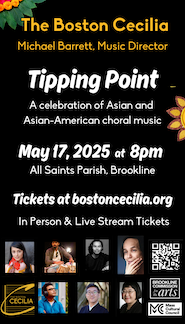Slobodeniouk and Boston Symphony draw a compelling through-line from Pärt to Mozart

Dima Slobodeniouk conducted the BSO in Arvo Pärt’s Tabula Rasa with violinists Alexander Velinzon and Lucia Lin Thursday night. Photo: Hilary Scott
Who says old dogs can’t learn new tricks?
The Boston Symphony Orchestra—now in its 144th season—trotted out a fresh one with conductor Dima Slobodeniouk on Thursday night: eschewing the usual practice of warming up onstage, the ensemble instead entered en masse, bowed together, and got immediately to the business of presenting Arvo Pärt’s Tabula rasa. Perhaps that should become the new tradition, since the directness of the gesture seemed to flow straight into the group’s subsequent, admirably focused music making.
Though the 89-year-old Estonian master has been an icon of contemporary music since the 1960s, his output is hardly a regular presence at Symphony Hall. In fact, this weekend marks the first-ever BSO performances of Pärt’s celebrated concerto for two violins, strings, and prepared piano.
Written for Gidon Kremer and Tatiana Grindenko in 1977, Tabula rasa navigates the composer’s familiar tintinnabuli style. Across its two sections, “Ludus” and “Silentium,” the soloists weave a diaphanous tapestry of slowly unfolding melodic lines in (mostly) their highest registers. The accompanying group occupies a lower tessitura and grounds the proceedings both rhythmically (in the first movement) and ritualistically (in the second).
On Thursday, BSO violinists Alexander Velinzon and Lucia Lin dispatched the unforgivingly exposed solo parts with a mix of delicacy and fearlessness. Though the pair’s intonation was suspect in some of the finale’s mesospheric noodling, their larger performance ably conveyed the hypnotic spirituality of Pärt’s musical language.
Slobodeniouk drew playing from the ensemble that was smartly balanced and rhythmically secure. The structure of “Ludus” emerged strongly, its floating patterns naturally ceding way to shapely, intense climaxes. While “Silentium” seemed to overstay its welcome by about a quarter, there was something engrossing about its ethereal play of colors. Vytas Baksys delivered the muted-chime-like keyboard part with cool precision.
One might expect to hear pealing bells in a setting of the Roman liturgy for the dead, yet that’s not the route Mozart took. Perhaps he would have, had the composer lived to complete his Requiem.
That eventuality, however, wasn’t in the cards and the character most responsible for the score’s completion—the Salzburg native’s one-time student, Franz Xavier Süssmayr—wasn’t among his teacher’s most prized or original pupils. Nevertheless, Süssmayr, despite being faced with a seemingly impossible task, managed to pull off his assignment better than not.

Dima Slobodeniouk conducted Mozart’s Requiem with soloists Erin Morley, Avery Amereau, Jack Swanson, and Morris Robinson. Photo: Hilary Scott
True, there’s a sense of freshness and originality being sapped over parts of the Requiem’s second half. Much of the choral writing in the “Sanctus” and “Agnus Dei” is dull, at least by comparison with that which came before.
But the contrapuntal episodes in these sections—the “Quam olim Abrahae” and “Osanna in excelsis” fugues—as well as the solo quartet interjections in the “Benedictus,” are invigorating. Also striking is the “Lux aeterna’s” reprise of music heard during the “Introitus”: whether that idea came from Süssmayr or Mozart, parts of the Requiem do point ahead to later efforts by Wagner, Mahler, and Schoenberg.
Also, Verdi. Though the Italian titan’s Missa pro defunctis often gets credit for marrying the church and the opera house, Mozart’s 80-years-older approach to the liturgy is just as defiantly theatrical. Where’s the dividing line between solo, ensemble, and choral numbers in this Mass as opposed to the same in, say, Figaro or Don Giovanni? What’s the difference between the latter’s Act 2 finale and the licking flames depicted in the Requiem’s “Confutatis”?
Perhaps those anticipations emerged more strongly than usual on Thursday because the night’s unabashedly modern approach to this favorite crowded the stage with so many performers. The results were sometimes predictable: though well-blended and warm, the full complement of the Tanglewood Festival Chorus and BSO periodically sounded blunt and lumbering.
Their strongest moments together—in the “Kyrie,” “Dies irae,” “Confutatis,” and “Lacrymosa”—sang with shapely purpose. Similarly striking were various instrumental spots, from the “Requiem aeternam’s” lilting introduction to the bold dynamic contrasts in the “Hostias” and the “Benedictus’s” radiant blend of brasses and woodwinds.
At the same time, the weird syncopations in the “Osanna” refrains lacked edginess and the “Domine Jesu’s” counterpoint danced too stiffly. In both outer movements, the TFC’s diction was periodically indistinct.
Regardless, the night’s soloists consistently impressed. The collective’s individual qualities—soprano Erin Morley’s silvery instrument; mezzo-soprano Avery Amereau’s luscious one; tenor Jack Swanson’s lean, resonant contributions; and bass Morris Robinson’s noble, oracular solos—were considerable.
Yet together the group exceeded the sum of their parts, especially across Mozart’s luminous ensemble writing in the “Tuba mirum” and “Recordare.” Robinson, alone among the tetrad, gamely sang along with his section in the TFC whenever he wasn’t performing solo duties.
If, ultimately, Thursday’s Requiem didn’t break the surly bonds of earth, it was pointing in that direction. Subsequent performances, one expects, will achieve even more.
The program will be repeated 1:30 p.m. Friday and 8 p.m. Saturday at Symphony Hall. bso.org
Posted in Performances
